Bonney Lake in Washington offers an exciting fishing escapade that is simply mind-boggling! The 16.9-acre lake in Pierce County is open year-round and presents a good chance to harvest stocked rainbow trout.
You’ll also come across naturally thriving communities of brown bullhead catfish, yellow perch, pumpkinseed sunfish, and largemouth bass. In this piece, we’ll share all the important details about fishing at Bonney Lake, including the depth of the lake, species to reel in, their size, and much more.
Size and Depth
In a sprawling 17-acre expanse, perched at a height of 608 feet, lies Bonney Lake. The Washington Department of Fish and Wildlife (WDFW) boat ramp is on the lake’s northwest shore, accessible via 74 Street E. The ramp comprises a shallow gravel surface, lacks restroom facilities, and offers limited parking.
Engaging in two-pole fishing is permissible. The maximum depth of Bonney Lake is 20 feet. Interestingly, Bonney Lake is adjacent to Lake Debra Jane, which spans 19 acres but has a shallower depth of less than 10 feet.
Fishing: 6 Species You Might Catch
Bonney Lake presents anglers of all skill levels with year-round fishing opportunities. Below are some species you may encounter in this lake, along with tips on how to catch them.
1. Rainbow Trout (Oncorhynchus mykiss)
Rainbow trout, highly esteemed game fish in Washington, are renowned for their tenacity and delectable flavor. Bonney Lake regularly receives stocked rainbow trout from the Washington Department of Fish and Wildlife (WDFW). Recent stocking records indicate 1,000 rainbow trout in April 2023, 382 rainbow trout in November 2022, and 1,000 rainbow trout in March 2022. The average size of the stocked fish ranges from 1.66 to 3 fish per pound.
Rainbow trout can be captured using bait, lures, and flies. Excellent bait choices for rainbow trout include worms, salmon eggs, cheese, and marshmallows. Effective lures encompass spinners, spoons, and jigs.
Flies mimicking insects, such as nymphs, dry flies, and streamers, can yield fruitful results. The optimal time for rainbow trout fishing at Bonney Lake is during spring and fall when the water temperature is cooler and the fish are more active.
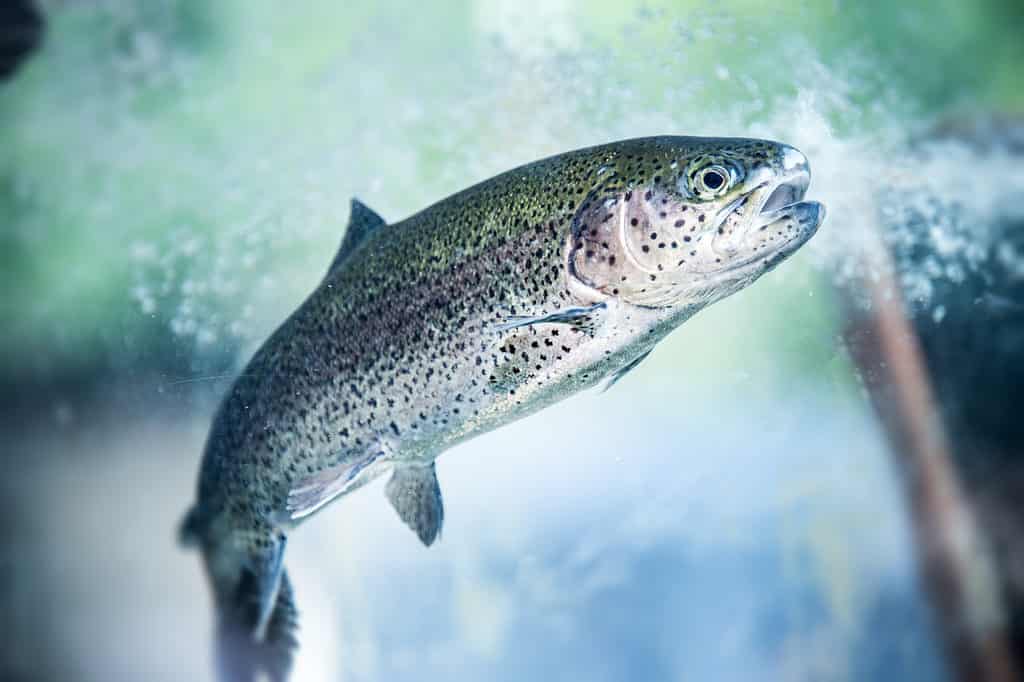
Bonney Lake in Washington State is a great spot for fishing, and it’s stocked with plenty of rainbow trout.
©iStock.com/Max2611
2. Brown Bullhead Catfish (Ameiurus nebulosus)
The brown bullhead is the most widespread among the three types of bullhead species discovered in Washington. One can easily recognize it by the solid barbs or serrations on the back of its pectoral spines and the coloring in its chin barbels. Like other catfish relatives, brown bullheads often dominate in slightly muddier and warmer waters, which are less preferred by most other fish.
They have the remarkable ability to withstand high water temperatures and low levels of dissolved oxygen, which would be fatal to many other game fish. The brown bullhead is equipped with a highly-developed sense of smell and touch. They excel at navigating through murky waters. On average, they measure between 8 and 12 inches, but they can grow even larger in thriving populations.
Catching brown bullhead catfish requires a simple fishing tackle and bait. Best bait choices include worms, chicken liver, shrimp, and cut bait. Fishing for them is viable at any time of day or night, although they tend to be more active after sundown. Targeting them near the lake bottom, where they seek refuge amidst rocks and weeds, presents the best chances of success.
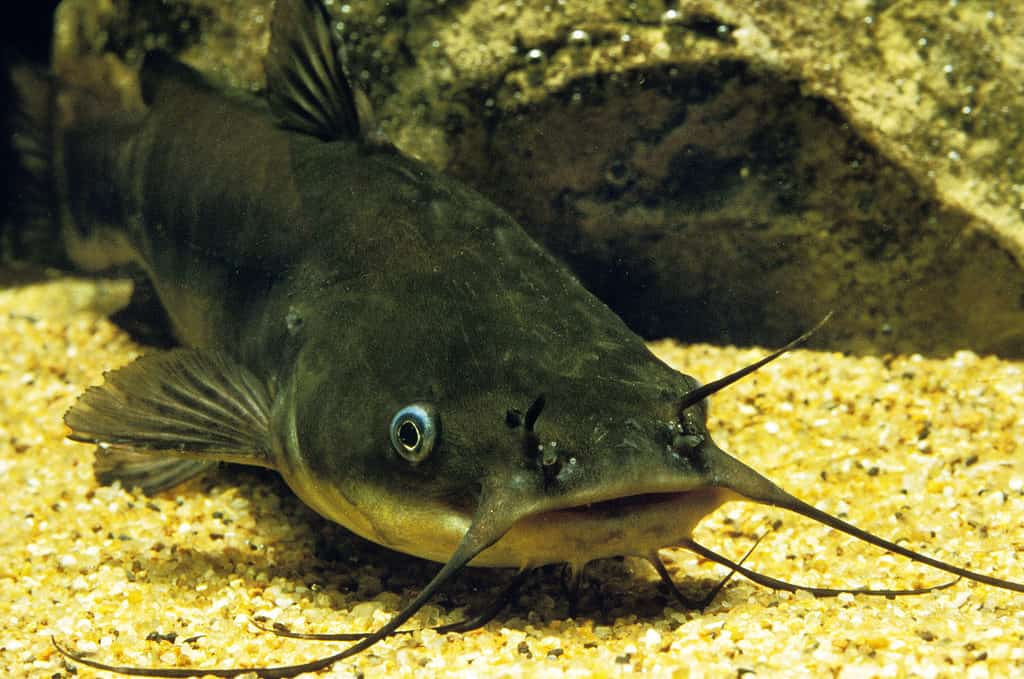
The brown bullhead catfish is a remarkable creature, capable of withstanding high water temperatures and low levels of dissolved oxygen.
©Slowmotiongli/Shutterstock.com
3. Largemouth Bass (Micropterus salmoides)
Largemouth bass, a highly sought-after game fish in North America, belong to the sunfish family and possess a huge mouth. Their pigmentation typically ranges from green to olive, complemented by a dark horizontal stripe along their sides. With potential lengths of up to 29 inches and weights of up to 22 pounds, although the average size is smaller, these bass exhibit noteworthy variability.
They prefer warm, shallow waters abundant in hiding spots like weeds, logs, rocks, or docks. However, how can you enhance your chances of a successful catch?
Employ a variety of lures and baits that imitate the natural food sources of largemouth bass. Plastic worms, spinnerbaits, crankbaits, jigs, topwater plugs, and live bait like minnows or nightcrawlers are proven effective.
- Concentrate your fishing efforts near the shorelines or structures that provide hiding places and strategic ambush points for bass. Seek out areas with dense weed beds, fallen trees, docks, or rocky formations.
- Experiment with different characteristics of your lures and baits, such as colors, sizes, shapes, and actions, until you determine the optimal combination for the prevailing conditions and fish temperament. Even subtle adjustments can yield significant results.
- Exhibit patience and persistence, for largemouth bass can be unpredictable. Don’t lose hope if you fail to attract a bite immediately. Instead, explore various locations, depths, speeds, and angles until you discover the sweet spot.
Why should you target largemouth bass at Bonney Lake? The experience proves both enjoyable and fulfilling for several reasons:
- Largemouth bass are formidable opponents, renowned for their strength and ability to provide anglers with thrilling challenges. Their acrobatic jumps and spirited runs upon being hooked add an exciting element to the pursuit.
- Largemouth bass populations at Bonney Lake thrive abundantly and sustainably, allowing for catches without detrimental effects on the ecosystem. These self-sustaining populations possess adaptability to diverse environments and conditions.
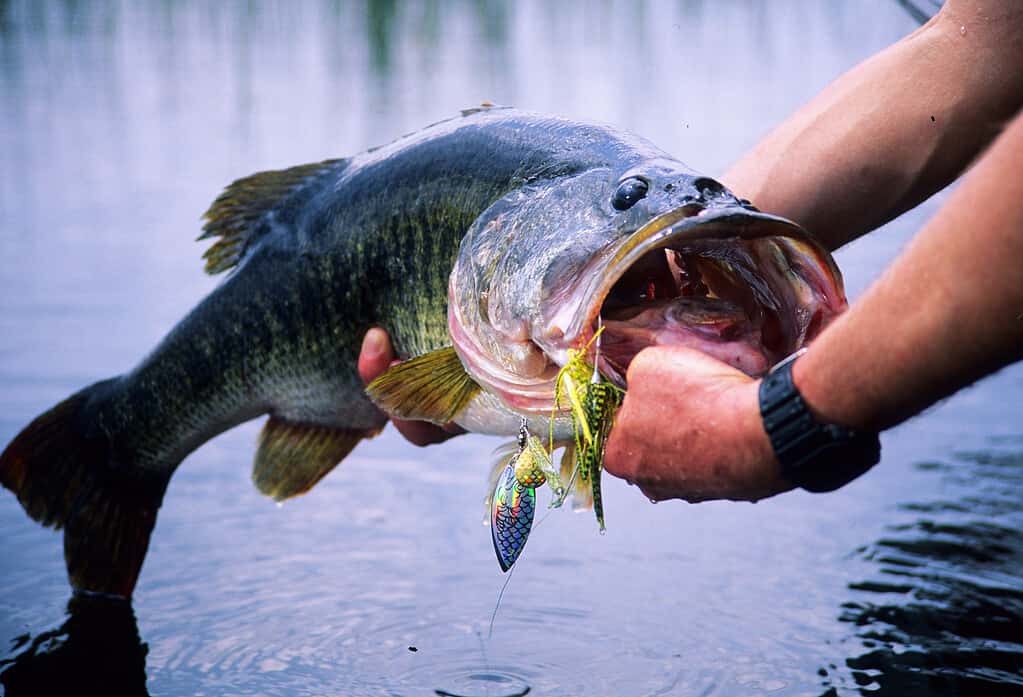
With Bonney Lake’s diverse environment and a healthy population of largemouth bass, you can experience the thrill of outsmarting one of the most formidable opponents in fishing.
©iStock.com/stammphoto
4. Bluegill (Lepomis macrochirus)
Bluegills can be identified among other types of sunfish by their small mouth, vertical bars on their sides, and a dark spot near the dorsal fin’s base. Typically, the dorsal fin has around ten spines, although it can have either 11 or 9 spines. Moreover, the spiny dorsal fin has a wide attachment to the soft dorsal fin. There are a total of three spines present in the anal fin. The dorsal and upper lateral parts are commonly characterized by a dark olive green hue, which gradually transitions into shades of orange, brown, or lavender on the lateral sides.
The ventral region typically displays tones of reddish-orange or yellow on the belly. The spawning of bluegills commences at a temperature of roughly 70 degrees Fahrenheit in the water. The spawning period typically reaches its climax between May and June but persists until autumn, when the water experiences a decrease in temperature. Due to their extended breeding period, bluegills exhibit a significant capacity for reproduction, often leading to excessive population growth when lacking sufficient predators or fishing activity.
A concentrated area with limited space has the potential to accommodate numerous nests, ultimately resulting in the formation of a breeding ground. Typically, male fish protect the nesting area until the eggs have hatched and the fry has departed. As baby fish mature, they switch their diet from plankton to aquatic insects and larvae. Approximately half of their food intake can potentially be made up of the larvae of midges.
How to Catch Bluegills
You can catch bluegill through various techniques. The crucial aspect is employing a method you feel assured about and relish.
1. Using a Bobber
To get a bluegill’s attention, it works best to present food slowly rather than making them chase after it. Bluegill fish are not big fans of pursuing their meals. One effective method is to use a small bait attached to a float, which dangles enticingly in front of them. The size of the bobber should be just right to keep your bait floating. The bluegill will sense the resistance if the bobber is too large and refuse to take the bait.
However, if the fish are in deeper waters, you might need to fish at greater depths. Dedicated bluegill fishermen consider slip bobbers indispensable because they allow for fishing at different depths, giving them more flexibility to catch fish.
2. Bottom Fishing
An ingenious way to boost effectiveness is to drop your bait into the lake’s depths gradually. You can gently propel your lure without any added heaviness with a light fishing rod, reel, and thin fishing line. The bottom fishing method has shown remarkable success, particularly when spring begins or after a cold period, as bluegill fish move to deeper water areas.
3. Drift Fishing
Drifting across the lake, aboard a boat, and placing your bait 10 to 15 feet below the surface, offers a fruitful way to catch bluegill. This approach is particularly beneficial when these fish hang around in the open waters at the end of summer. Navigating toward areas where you’ve previously spotted clusters of bluegill is wise to boost your fishing success.
4. Using a Fly as Bait
Fly fishing is not limited to trout alone, as it can bring immense excitement and fruitful results when targeting bluegill. The allure of artificial flies resembling tiny insects is irresistible to bluegill, given their substantial reliance on these creatures for sustenance. Unlike those choosy trout, bluegill is much more flexible when it comes to its fly preferences. Using small and dark flies generally works like a charm in luring them in.

Bluegills can be found in Bonney Lake and are identified among other types of sunfish by their small mouth and vertical bars on their sides.
©Stacey Ann Alberts/Shutterstock.com
5. Yellow Perch (Perca flavescens)
Yellow perch, part of the Percidae freshwater fish family, boasts many species, some of which are delectable. However, it is crucial to acknowledge that most species are too little for human capture or consumption. A staggering 160 species of darters exist, constituting an impressive 20% of all fish in the United States. Sauger and walleye are close relatives of the yellow perch. Within the Percidae family, the yellow perch enjoys widespread distribution and is highly regarded by numerous fishing enthusiasts.
Yellow perch exhibits a vibrant hue, ranging from verdant green to golden yellow, with six to eight wide, shadowy vertical stripes spanning from the dorsal region down to below the lateral line. Amid their breeding season, their lower fins assume a shade of orange, while their underbelly displays a pale, whitish tone.
Their physique takes on an elongated shape, appearing slightly arched due to the most profound section of their body commencing at the first dorsal fin and gradually narrowing toward the onset of the second dorsal fin. Notably, their dissimilarity from walleye and sauger lies in their absence of canine teeth and their generally deeper bodily structure.
How to Catch Yellow Perch
While yellow perch can be targeted year-round, they are more abundant in winter and early spring. Though not renowned for their aggressiveness, yellow perch become quite spirited adversaries when encountered using spinning or spin-casting equipment in cold waters.
Their preference for clear and cool habitats, as opposed to murky or muddy surroundings, contributes to their robust and snowy flesh, which possesses a taste comparable to its close relative — walleye.
As social animals, yellow perch congregate in schools and are frequently captured by anglers in open waters. During spring migration, they can be effectively caught when seeking warm coastal areas within bays and gentle currents to reproduce. Primarily favoring refreshing waters, these perch congregate at deeper depths when surface temperatures rise, although they venture closer to the shallows for nourishment.
The prime fishing spots are typically the shallow lakes’ weed beds, where fishing near or directly on the lakebed is advisable. Yellow perch are ensnared using various baits and lures, including live minnows, live worms, small minnow-like plugs, spinners, spoons, jigs, and combinations of jigs and spinners, which are particularly effective. Using small jigs with hair or curl-tail grubs yields exceptional results.
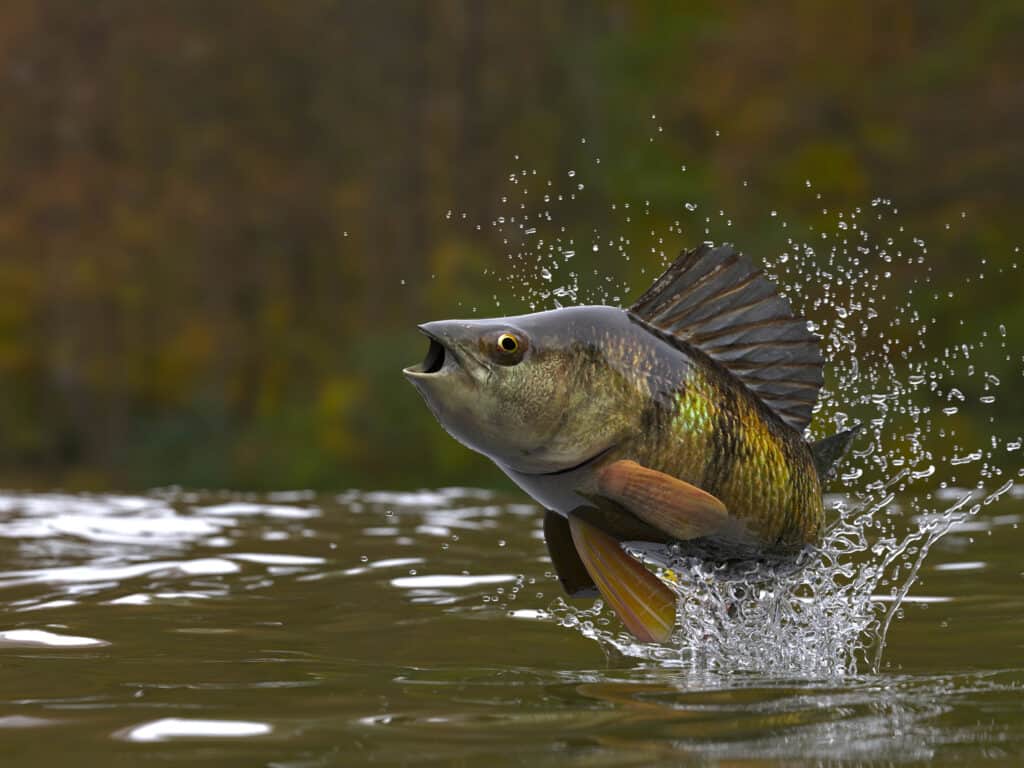
Bonney Lake is the perfect place to go fishing for yellow perch, which are abundant during the winter and early spring and have a delicious flesh that tastes like its relative – walleye!
©bekirevren/Shutterstock.com
6. Pumpkinseed Sunfish (Lepomis gibbosus)
Pumpkinseed sunfish derive their name from their body’s resemblance to a pumpkin seed’s flat, ovular shape. These freshwater residents, belonging to the sunfish family, constitute a plentiful and easily captured species, rendering them an ideal catch for budding anglers.
Pumpkinseed sunfish boasts an exquisitely vibrant appearance, characterized by a saucer-shaped physique. Their bodies showcase diverse blue, green, and orange hues, accompanied by horizontal patterns adorning their cheeks. Other distinguishing features include dark earflaps and a vivid red or orange perimeter near the earflap.
While fully matured pumpkinseed sunfish can reach up to twelve inches in length, the average pumpkinseed fish measure between four and six inches. Their typical weight rarely exceeds one pound.
How to Catch Pumpkinseed Sunfish
Pumpkinseed sunfish are full of energy during daylight hours. The most successful approach involves using lengthy 18-foot poles for pole fishing to snag these fish. In the hotter months, bait casting and still fishing are fruitful methods. During different times of the year, experimenting with drift and fly fishing can yield positive outcomes.
Opting for uncomplicated lures, such as a setup with a bobber and a small sinker, tends to be the most effective. Smaller pumpkinseed sunfish typically linger near the shoreline, while their larger counterparts are often discovered farther out in offshore waters.
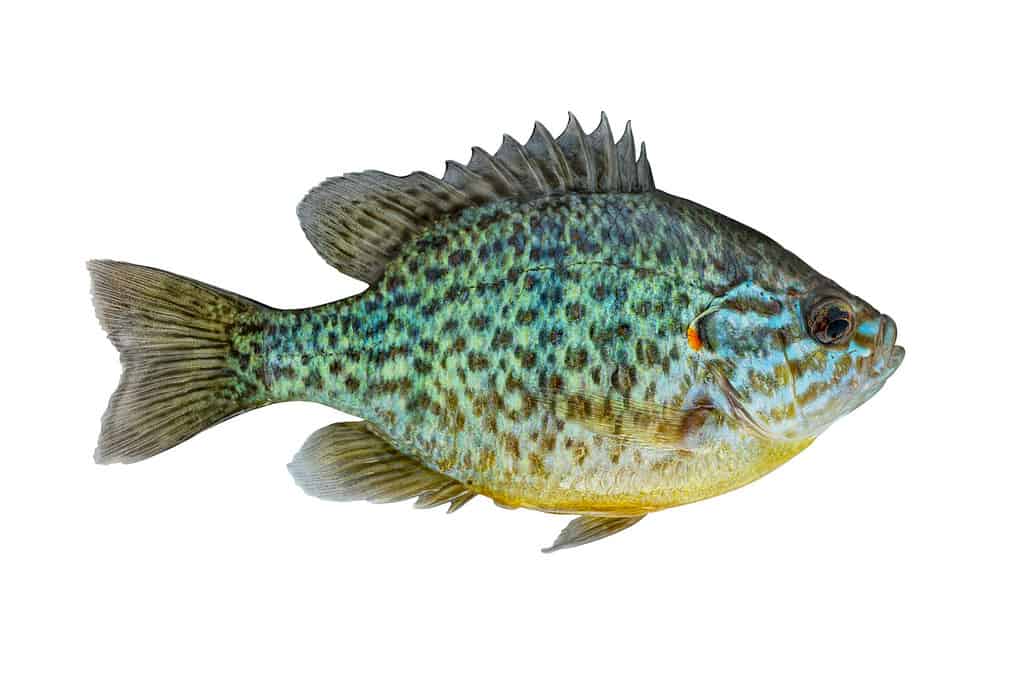
Pumpkinseed sunfish derive their name from their body’s resemblance to a pumpkin seed’s flat, ovular shape.
©FedBul/Shutterstock.com
Additional Information
Besides being an awesome fishing spot, Bonney Lake lures nature lovers with its mind-blowing surroundings. On days of clear skies, the majestic presence of Mount Rainier provides a stunning backdrop.
Venturing into the neighboring lakes like American Lake, Spanaway Lake, Pine Lake, Wilderness Lake, and Lake Bradley expands the range of fishing opportunities and species encountered. Bonney Lake remains a hidden treasure adored by avid anglers and nature worshippers.
Beyond the Surface: Unraveling Bonney Lake’s Fishing Treasures
Bonney Lake in Washington offers an awe-inspiring and captivating fishing experience that will leave anglers bewildered. With its 16.9-acre size and year-round accessibility, this lake is home to thriving communities of rainbow trout, brown bullhead catfish, yellow perch, pumpkinseed sunfish, and largemouth bass.
There are ample opportunities to reel in a rewarding catch, from using bait, lures, and flies to employing tactics like bottom fishing, drift fishing, and angling with a bobber. Furthermore, Bonney Lake’s natural beauty adds to its allure.
With the magnificent Mount Rainier as a backdrop and nearby lakes offering additional fishing opportunities, this hidden treasure in Washington captivates avid anglers and nature enthusiasts.
The photo featured at the top of this post is © Nicholas Steven/Shutterstock.com
Thank you for reading! Have some feedback for us? Contact the AZ Animals editorial team.







